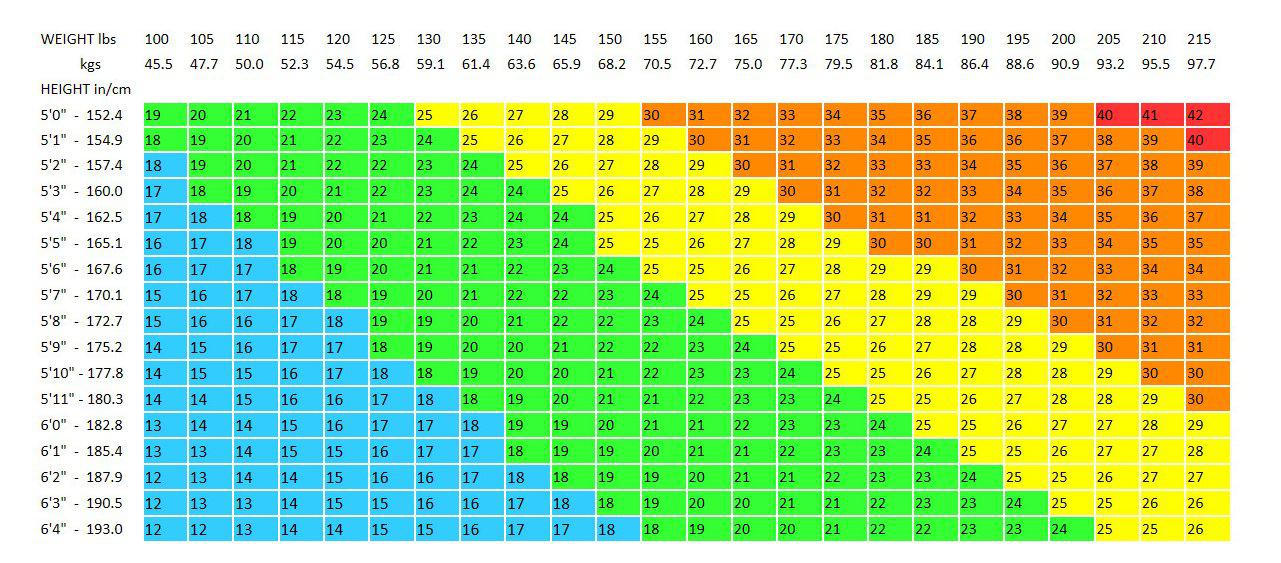What do you want to do?
BMI Calculator
Body Mass Index (BMI) is a popular metric to help you track your health based on body fat constituency. ...Read More
Your BMI is
22.7
Normal
BMI RANGE AND CATEGORY CHART
BMI table for adults
| CATEGORY | BMI RANGE kg/m2 |
| Underweight | <18.5 |
| Normal Weight | 18.5 - 24.9 |
| Overweight | 25 - 29.9 |
| Obese | >30 |
What is BMI?
BMI is short for Body Mass Index. It is a metric that provides a rough idea about the amount of fat a person’s body constitutes and whether they are required to reduce it or not. By calculating BMI using a BMI calculator, you can determine whether you have a healthy weight or are obese, overweight or underweight.
This information can help you keep a check on your health and take necessary action towards your fitness. By consistently checking your BMI, you can keep major health issues like diabetes, cholesterol and heart conditions at bay.
Underweight – BMI less than 18.5
Normal weight – BMI between 18.5 and 24
Overweight – BMI between 25 and 29.9
Obese – BMI above 30
What Is a BMI Calculator?

The BMI Calculator is used to calculate the Body Mass Index and corresponding weight status, taking Age into consideration. BMI Calculator is a tool that helps to determine your health status and easily determine whether you are overweight, underweight or healthy as per your BMI.
A body weight index calculator requires you to enter certain parameters like your height, weight and age. On the basis of this information, this tool will determine your BMI and will let you know about your possible health status.
How to Calculate BMI?
To calculate BMI using the standard formula, you can follow the steps below:
Step 1: Multiply your height by itself.
Step 2: Divide your weight with the answer above.
Ideal BMI for Men
The BMI calculation requires the height and weight of any person and is the same for everyone above 20 years old. The standard BMI for men ranges from 18.5 to 24.9. If a person's BMI is below 18.5, he is underweight and must consider taking measures to increase his body weight.
On the other hand, if a person’s BMI is 30 or higher, as per calculation he is overweight and is prone to obesity-related health conditions. To avoid such conditions, he must take measures to reduce his weight.
Ideal BMI for Women
Similar to men, the ideal BMI for adult women also ranges from 18.5 to 24.9. If a body index calculator shows your BMI below 18.5, you are underweight. However, if the calculator shows a BMI above 25, you are overweight.
Ideal BMI for Children
Unlike adults, the body fat constituency in children changes faster with age. It is also normal for boys and girls to have more body fat during their early teen period compared to adults.
Although the formula to calculate BMI for children is the same as for adults, gender and age play a pivotal role here. This is simply because male and female height and weight change rapidly with the onset of puberty in children. Their BMI needs to be measured using the same calculator and then compared with children of the same age and gender category.
For children, if the result on the BMI calculator is between the 5th to 85th percentile on clinical growth charts, it is considered a healthy BMI.
Risks Associated with Being Overweight
Here is a list of crucial health risks that overweight people are vulnerable to:
- Hernia
- Breathing problem
- High blood pressure
- High triglycerides
- Type 2 diabetes
- Stroke
- Heart conditions
- High LDL cholesterol level
- Low HDL cholesterol in blood, increasing the chances of coronary artery blockages and heart attack
- Insulin resistance
- Complications in gallbladder
- Gout
- Cataract
- Mental health issues and clinical depression
- Urge to frequent urination or stress incontinence
- PCOS in women leading to menstrual irregularities and lower chances of fertility
- Osteoarthritis or breakdown of cartilage in joints leading to pain in joints
- Sleep apnea
Risks Associated with Being Underweight
The points below list some diseases and health issues that can affect an underweight person.
- Growth and development delays in children
- Malnutrition
- Anaemia
- Vitamin deficiencies
- Brittle bones or osteoporosis
- Weakened immunity leads to failure of body's ability to defend against diseases
- Disruption in the menstrual cycle in women and complexities with conception
- Hormonal imbalances
Is BMI Reliable?
A BMI calculator is a reliable tool to calculate body fat constituency in both adults and kids regardless of their gender. However, this is a tool for getting a rough idea of your health from your current weight status. It can also produce misleading results when not comparing the age and gender of the person.
You can use the BMI calculator to track your weight journey to keep potential illnesses away. You cannot use this calculator as a diagnostic tool.
BMI Chart
A person’s Body-Mass Index, or BMI, helps them check whether they’re a healthy weight for their height. If a person weighs less or more than the recommended weight for their height, it could lead to health issues in the future. While BMI is not the only factor individuals should consider while working on their health and fitness, it is a good starting point. To understand what your BMI is, you need to know your height and weight. You can then check your BMI against the BMI chart:

The table below displays BMI for adults above 20 years old. The result on the BMI calculator for adults is the same for both men and women.
BMI |
Weight Status |
Below 18.5 |
Underweight |
18.5-24.9 |
Healthy |
25-29.9 |
Overweight |
Above 30 |
Obese |
BMI Formula
The standard formula to calculate BMI looks like this.
BMI= Your weight / (height^2)
To understand this, let’s assume, your height is 177 cm or 1.77 m and your weight is 70 kg.
Therefore as per the formula above, your BMI will be
BMI= 70/ (1.77*1.77)= 22.36
So, according to the body weight index calculator, your BMI falls between 18.5 and 25 which means you are healthy.
BMI for Kids
You can calculate BMI for children using the same formula as mentioned above. However, while analysing, the BMI calculator takes the child's age and gender into account. This is because the body fat constituency in girls and boys can vary and change rapidly during their teenage years.
Therefore, the BMI percentile for age and sex classifies children as underweight, overweight and healthy. A body index calculator must only be used as an initial screening factor to determine a child’s health. Medical practitioners must consider other factors for a thorough health assessment.
BMI Table For Children and Teens, Age 2-20
The table below displays age-for-sex BMI categories and their corresponding percentile for children and teens.
BMI Percentile |
Health Status |
Less than 5th percentile |
Underweight |
5th percentile to 85th percentile |
Healthy weight |
85th percentile to 95th percentile |
Overweight |
Equal or more than 95th percentile |
Obese |
You can use the growth charts given by the Indian Academy of Pediatrics (IAP) to calculate height, weight and BMI of children of the same age and gender.
Limitations of an Online BMI Calculator
Adults
- BMI Calculator is a simple tool that roughly calculates your body fat based on your height and weight. It does not take several other factors into consideration that can affect the health of a person. Thus, the BMI health status is not always accurate.
- Women tend to have more body fat than men for similar BMI.
- Even if you have an average weight, your BMI might categorise you as overweight. Thus, with this, a BMI calculator can spread misinformation.
...Read More
Young Adults and Children
Unlike adults, BMI calculators require more information than a person’s height and weight for children. To evaluate BMI status for young adults and children, the calculator needs to know details like age and sex.
Yet the tool can provide a rough result for primary assessment. Height and weight can change very quickly in children before and after they attain puberty. The effect of puberty on physical appearance can also be drastically different. Hence, you cannot rely on body mass index value alone.
...Read More
Alternate Estimates of Weight-Related Health Risks
As already discussed, BMI calculators are not always a reliable option for knowing your health status. Instead of BMI, you can use the following alternative methods to track your weight.
Waist Circumference
Measuring your waist helps to determine fat stored in your body more accurately than BMI. With waist circumference, you can know where most fat in your body is getting stored and whether you are overweight or not.
If your waist circumference is above 35 inches for women and 40 inches for men, you might run a higher health risk of contracting chronic illnesses. To measure your waist circumference, place a tape around your mid-region, above your hip bones and measure the circumference.
Waist-to-Hip Ratio
Waist-to-hip ratio is another way for doctors and dieticians to determine whether you are overweight, obese or underweight. To calculate your health status, this ratio takes fats stored around your hips, waist and buttocks into consideration.
Unlike BMI, waist-to-hip ratio is a comparison between the fat stored around your waist and hips. As per research, people who carry more weight around their waist-hip region tend to be overweight. They stand at high risk of health conditions like type-2 diabetes and other health issues.
The World Health Organisation states that the ideal waist-to-hip ratio for men is 0.9 or less and for women, it is 0.85 or less.
Waist-to-Height Ratio
This ratio compares your waist circumference to your height and presents results to reflect fat distribution in your body. According to studies, a person's weight-to-height ratio is a good indicator of their vulnerability to heart attack and other health conditions related to obesity.
The ideal weight-to-height ratio is 0.50 for both men and women. A ratio above 0.50 indicates that the person is verging towards obesity and will be vulnerable to health issues like diabetes and high cholesterol.
BMI Calculator - FAQs
How do I calculate my BMI?
You can calculate BMI manually by using the formula: BMI= Weight / (height^2). For instant results, you can opt for a BMI calculator available online.
Is a BMI of 20 a lot?
According to the BMI chart for adults, if your body mass index is 20, you are in great shape and health.
What is the ideal BMI range?
The ideal BMI range for both male and female adults is between 18.5 and 24.9.
How is BMI measured?
To measure body mass index using the BMI calculator, you must enter your height, weight and age.
What is the ideal BMI for a man?
The ideal BMI for a man above the age of 20 years is 18.5 to 24.9.
What is the ideal BMI for a woman?
The ideal BMI for an adult woman is 18.5 to 24.9.
How much should I weigh for my height and age?
Consider checking your ideal weight according to height and age in a BMI chart. To resolve any confusion regarding the same, consider consulting a medical expert.
ALL CALCULATORS
Here's all you should know about life insurance.
We help you to make informed insurance decisions for a lifetime.

Popular Searches
- term insurance
- Term Insurance Calculator
- 1 Crore Term insurance
- Best Investment Plan
- 1 crore investment plan
- ULIP
- Best Savings Plan
- Best Retirement Plan
- Compound Interest Calculator
- Pension Calculator
- ULIP Calculator
- Income Tax Calculator
- Investment for beginners
- 5 year Investment Plan
- 10 year Investment Plan
- 20 year Investment Plan
- Child Insurance Plan
- ULIP vs. SIP
- Insurance vs. Investment
- Long Term Investment Plan
- Short Term Investment Plan
- life Insurance policy
- life Insurance
- child education planner
This interactive does not constitute an offer or solicitation for the purchase or sale of any financial instrument or as an official confirmation of any transaction. HDFC Life Insurance Company Limited or any of its affiliates/ group companies shall not be in any way responsible for any loss or damage that may arise to any person from any inadvertent error in the information reported by the interactive.
The information being provided through this interactive is provided for your assistance/ information only and is not intended to be and must not alone be taken as the basis for an investment decision (“Information”). The recipient/ user assume the entire risk of any use made of this Information. Each recipient /user of this interactive should make such investigation as it deems necessary to arrive at an independent decision while making an investment and should consult his own advisors to determine the merits and risks of such investment. The investment discussed or views expressed may not be suitable for all investors. HDFC Life Insurance Company Limited and its affiliates, group companies, sales staff, financial consultants, officers, directors, and employees may have potential conflict of interest with respect to any recommendation, related information or opinions.
This Information should not be reproduced or redistributed or passed on directly or indirectly in any form to any other person or published, copied, in whole or in part, for any purpose. This Information is not directed or intended for distribution to, or use by, any person or entity who is a citizen or resident of or located in any locality, state, country or other jurisdiction, where such distribution, publication, availability or use would be contrary to law, regulation or which would subject HDFC Life Insurance Company Limited and its affiliates/ group companies to any registration or licensing requirements within such jurisdiction. The distribution of this Information in certain jurisdictions may be restricted by law, and persons in whose possession this Information comes, should inform themselves about and observe, any such restrictions. The Information given in this interactive is as of the date of this report and there can be no assurance that future results or events will be consistent with this Information. This Information is subject to change without any prior notice. HDFC Life Insurance Company Limited reserves the right to make modifications and alterations to this statement as may be required from time to time. However, HDFC Life Insurance Company Limited is under no obligation to update or keep the Information current.
Neither HDFC Life Insurance Company Limited nor any of its affiliates, group companies, directors, employees, sales staff, financial consultants or representatives shall be liable for any damages whether direct, indirect, special or consequential including health, physical well being, lost revenue or lost profits that may arise from or in connection with the use of the Information. Past performance is not necessarily a guide to future performance.
ARN - INT/MC/01/24/7566


